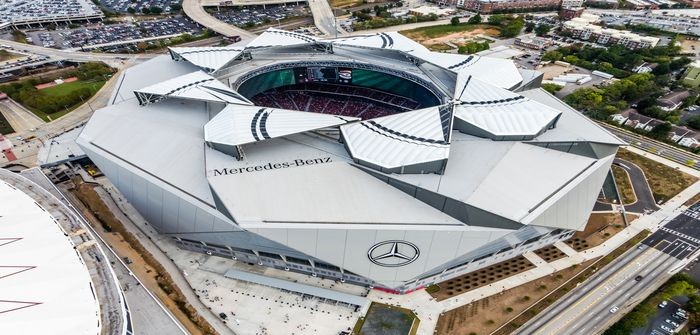Mercedes-Benz Stadium stands as an architectural marvel in Atlanta, Georgia, captivating sports fans and event-goers alike. But when was Mercedes-Benz Stadium built and what makes it so remarkable? This state-of-the-art venue, home to the NFL’s Atlanta Falcons and MLS’s Atlanta United, opened its doors in September 2017, marking a new era in stadium design and fan experience.
The vision for Mercedes-Benz Stadium was ambitious from its inception: to break away from conventional stadium design and create something truly unique. Principal at HOK, Bill Johnson, noted the industry’s plateau, particularly with retractable roof stadiums, and aimed to reinvent stadium architecture. In a time where fans have abundant entertainment options at home, the stadium needed to be more than just a venue; it needed to be a spectacle, an experience in itself.
A New Era of Stadium Design: The Petal Roof and Halo Board
Opened in September 2017, after a meticulous construction process and a budget exceeding US$1.5 billion, Mercedes-Benz Stadium immediately distinguished itself with its groundbreaking retractable roof. Unlike typical side-to-side mechanisms, this roof operates with eight petal-like pieces that move outward from a central point, resembling a blooming flower. This innovative design, conceived by HOK in collaboration with TVS Design and engineers BuroHappold, with Birdair as the ETFE specialty contractor for the roof and facade, allows the roof to open in a swift 10-12 minutes.
The retractable roof’s design was intended to be a spectacle in itself. Johnson explained, “Our beginning idea was when the roof opened, it needed to be something special and unexpected. We imagined this pinpoint of light that, as the roof opened, would grow and become this dramatic opening.” However, this innovation came with its challenges, leading to construction delays as the team navigated the complexities of this unprecedented design. Johnson admitted, “With that innovation comes a learning curve every step of the way. It was more difficult and involved than anything anybody had anticipated.”
Adding to the stadium’s uniqueness is the 360° halo video board, a first-of-its-kind digital LED display curving around the inner circumference of the roof opening. Developed by Daktronics with IBM’s technical infrastructure, this massive 63,800ft² display is the largest video board in any North American stadium. Mike Gomes, Senior Vice President of Fan Experience for AMB Sports & Entertainment Group (AMBSE), emphasized the halo board’s impact: “A lot of people talk about the roof, but as cool as it is, it’s probably not as special as the video halo. I think that seems to be the thing people are mesmerized by. Wherever you are in those concourses you see that digital display. It’s very anchoring. You’re always connected to what’s going on. There’s very few places in the building where you don’t have a view to the halo.” This connectivity is crucial for modern fan experience, ensuring that fans remain engaged even when they leave their seats.
Transparency and Fan Experience: A View of the City
Beyond the roof and halo board, Mercedes-Benz Stadium prioritizes transparency and connection to its urban surroundings. The stadium’s design incorporates extensive glass and transparent ETFE, surpassing even facilities known for their openness. The angular metal facade transitions to expansive glass walls below, manufactured and installed by Crown Corr. These glass walls not only provide natural ventilation but also offer breathtaking views of the Atlanta skyline.
Rich McKay, President of the Atlanta Falcons, highlighted the importance of this transparency: “We needed a building that when open could feel open. We wanted transparency. We wanted it to be an invitation to come to this building, and a window to the city. The money shot on TV will be this huge opening in the east side of the building facing downtown.”
Balancing light and heat gain was a key design challenge with such extensive transparency. While the initial plan included clear roof petals, studies revealed it would be impossible to manage the heat. Johnson explained, “It’s always a balancing act in terms of how clear and open the building can be.” The south and west facades, facing significant heat gain due to the ETFE, were addressed with a frit applied to the material. The frit’s opacity varies, being fully clear on the east and north sides (offering city views) and up to 70% opaque on the west to mitigate heat.
Revolutionizing Fan Experience: Affordable Concessions and Enhanced Quality
Mercedes-Benz Stadium’s commitment to fan experience extends beyond architectural spectacle. AMB Group and the Falcons conducted extensive fan focus groups to understand what truly mattered to ticket holders. McKay noted a shift in focus: “For so long stadia were about increasing revenue, but in doing that, they’ve often missed how the true fan and their experience is impacted.” The stadium aimed to reverse this trend, believing that a positive fan experience would naturally drive revenue.
One significant change was the pricing of concessions. Recognizing fan frustration with inflated prices, Mercedes-Benz Stadium deliberately targeted lower, more affordable prices. Gomes stated, “Fans have been gouged for years. We all know it. Every ballpark, every arena, we overpay for food and beverage… We aggressively hit that head on. Our pricing tries to have fans pay what they would at a local restaurant.”
To ensure profitability with lower prices, the stadium focused on increasing concession volume, quality, and efficiency. This involved adding significantly more cooking capacity within the stadium itself, moving away from reliance on external commissaries. The stadium also features 65% more points of sale than its predecessor, the Georgia Dome, minimizing wait times and enhancing accessibility. Gomes summarized the strategy: “From a concession standpoint, it’s not easy to say, ‘Let’s lower prices’. You have to approach it assuming you’ll have a pricing model that changes demand.”
A Landmark for Atlanta: Built for the Future
In conclusion, Mercedes-Benz Stadium, built and opened in September 2017, is more than just a sports venue; it’s a landmark that has redefined stadium design and fan experience. Its innovative retractable roof, the mesmerizing halo video board, commitment to transparency, and revolutionary approach to fan concessions have made it a standout venue. Johnson aptly summarized its significance: “Great cities have great structures people remember. This will be that building for Atlanta. This was not an easy project to pull off. But there’s a reason there’s already over a billion dollars in sponsorship for this building. Great design means something to people.” Mercedes-Benz Stadium stands as a testament to innovative design and a commitment to putting the fan experience first.

